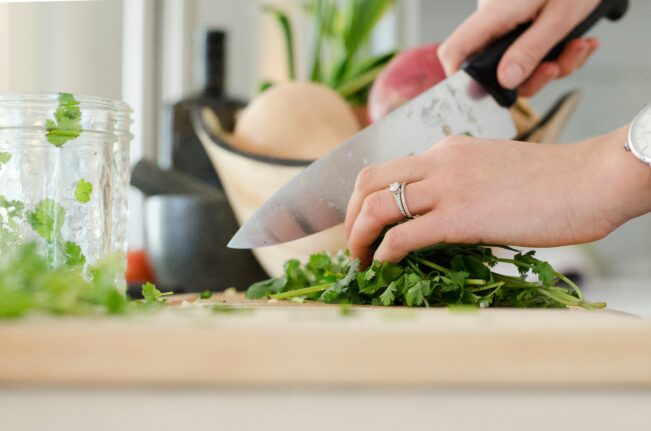Because over 65% of the immune cells in the body are positioned in the gut, the diet can dynamically influence the immune system [1]. This means the health of your immune system and its ability to protect your body against invading pathogens depends on balanced uptake of nutrients. Some nutrients, however, are more important than others when it comes to immune system function.
Protein and energy malnutrition is linked with the destruction of cell-mediated immunity, phagocyte function, secretion of immunoglobulin A, antibody concentration, and cytokine production [1]. Restricted, low-calorie diets have been shown to cause decreases in the proliferation of some immune cells and antibody response [1]. Protein insufficiency, specifically, weakens and alters the function of the immune system’s physical barriers. In response to protein insufficiency, collagen and connective tissues in skin are deposited and constructed differently, and skin becomes thinner. It also causes a drop in the number of antibodies in mucous, and reduces the size of microvilli in the intestine, allowing more pathogens to pass into the bloodstream [1].
Individual amino acids are also important in the nourishment of the immune system. Together, cysteine, glutamate, and glycine make up the body’s master antioxidant, glutathione (GSH). GSH is important to immune response, as it can reduce viral replication by interfering with inflammatory mediators [1]. Branched-chain amino acids (BCAAs – leucine, isoleucine, and valine) can preserve lymphocytes and glutamine concentrations after exercise which are two central factors for immune function [1]. Similarly, arginine treatment has been demonstrated to promote nitrogen balance, T cell response, lymphocyte function, and stimulate arginine transport in the liver [1].
All of these amino acids are present and abundant in a serving of chicken. Chicken is also a source of zinc and magnesium, two important cofactors for the immune system. The immune system is made up of both physical barriers and chemical reactions. Many of those reactions require cofactors, or helper molecules in order to function properly. Zinc acts as a cofactor for over 300 enzymatic reactions, is necessary for the proliferation of new immune cells, and can directly mediate inflammation [2]. Magnesium is also involved in over 300 biochemical reactions in the body, one of which is as a cofactor in the production of antibodies [3]. Magnesium deficiency is linked with a variety of symptoms related to a weakened immune system [3]. The almonds found in this recipe are an even richer source of magnesium and zinc, with one ounce providing about 20% of your daily recommended intake of magnesium and 10% of your daily recommended intake of zinc [4].
Another important ingredient in this recipe is cranberries, which provide an excellent source of vitamin C. Vitamin C is fairly well-known as an immune-boosting vitamin. It is a required cofactor for the movement of neutrophils (white blood cells) to the site of invaders, and for the engulfment and breakdown of pathogens [5]. It also participates in pathways that protect tissue from excessive damage by supporting the breakdown and removal of spent immune cells once they have finished their job [5]. The added lemon juice in this recipe will give its vitamin C content a further boost.
Curry Chicken Salad
Recipe by Kelly Fitzjarrell Guntermann
Ingredients:
2 tablespoons olive oil
2 ½ cups chicken (boneless, skinless thighs preferred, about 4)
2 teaspoons curry powder
2 cloves garlic, finely chopped
⅓ cup chicken stock or white wine (to deglaze chicken pan)
½ cup mayonnaise
¼ cup sliced almonds
¼ cup chopped dried cranberries (unsweetened for no added sugar)
¼ cup fresh chopped cilantro
3 stalks of celery
3 green onions —both white and green parts
juice of a half a lemon
Salt and pepper, to taste
Instructions:
Heat olive oil in a frying pan to medium/high heat. Coat chicken thighs in 1 tsp. curry powder, salt, and pepper and place them in the pan, smooth side down. Let the thighs sear for about 5 minutes without moving them. After they release easily from the pan, flip them over and cook for 6 minutes on the second side. Add chopped garlic to the pan and cook for 1 more minute before adding wine or chicken broth. The liquid will allow you to scrape all of the flavor off of the pan with your spatula. Continue to cook until the chicken is no longer pink (1 to 3 more minutes). Remove the chicken from heat and let it rest while preparing the rest of the ingredients (leave any remaining liquid in the pan for now).
Chop celery, cilantro, and cranberries to your desired size. Thinly slice green onions from root to tip on a bias (diagonally). Cube cooled chicken thighs and toss them back in your pan, coating cubes in any pan sauce that remains.
In the bottom of a large bowl, stir together mayonnaise, lemon juice, and remaining 1 tsp curry powder. Add chicken, chopped ingredients, and sliced almonds to the bowl and toss to coat. Add salt and pepper to taste, if desired.
Serve on a bed of greens, in a sandwich or wrap, or with crackers. Salad will keep in the fridge for 3-4 days.
References
- https://www.tandfonline.com/doi/full/10.1080/09540105.2015.1079600
- https://web.archive.org/web/20200326074140id_/https://www.cambridge.org/core/services/aop-cambridge-core/content/view/S0029665100000781
- https://pubmed.ncbi.nlm.nih.gov/3075245/
- https://www.medicalnewstoday.com/articles/269468#benefits
- https://www.mdpi.com/2072-6643/9/11/1211?ref=blog.vitable.com.au
